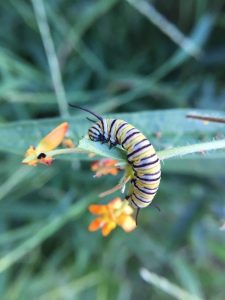
Milkweed Plants Gain Popularity
Monarch Butterfly (Danaus plexippus) populations are crashing and people have taken notice! In part because, unlike the usual heartbreaking stories of declining species, there’s something simple that people can do right now to help the Monarch: Plant Milkweed!
Until recently Milkweeds were considered a pesty weed. Now they are now selling out at native plant sales on a regular basis. Their rise in popularity has everything to do with people’s desire to aid Monarchs. And it doesn’t hurt that Milkweeds are native, hardy, and colorful! Milkweeds belong to the genus Asclepias, named after the Greek God of Healing due to their many medicinal uses. Their common name is for the milky sap that leaks out of the stem and leaves when cells are damaged. This milk contains cardiac glycosides which can be toxic to animals but only if consumed in large quantities.
A Gracious Host
Milkweeds are the host plant of the Monarch Butterfly. This means that Monarch adults only lay their eggs on milkweed plants. Monarch caterpillars feed exclusively on Milkweeds, and they are voracious feeders. A Monarch caterpillar can completely consume an entire Milkweed leaf in less than five minutes! In the 9-14 days that they exist as a caterpillar, they gain 2,700 times their weight. That’s a lot of Milkweed that they need! And it is crucial that Monarch caterpillars eat their fill of Milkweed because that is what fuels their grueling 3,000 mile migration south that they endure as adults.
Let’s Plant Milkweed!
So let’s all plant Milkweed in our yards! But with over 140 species of Asclepias worldwide, it is important that you select the appropriate species for your region and yard. To best help Monarchs, the varieties that you plant must be native to your area. In Delaware there are 13 species of native Milkweed, although many of them are not available commercially. There are 3 species that are native to Delaware and readily available commercially: Common Milkweed (Asclepias syriaca); Butterfly Milkweed (Ascelpias tuberosa); and Swamp Milkweed (Ascelpias incarnata).
Which Species is Right for You
My favorite is the Butterfly Milkweed. This hardy species loves dry, poor, sandy soils and full sun. It does great in most yards and gardens. The flowers are a bright orange, and will give any space an attractive pop of color. The plant achieves 1-3 feet in height and blooms May through July. Butterfly Weed will spread wherever you allow it to. I planted 3 plugs in a small flower bed and had a full bed with plenty of Monarch caterpillars chowing down within 2 years.
Are you lucky enough to have a small depression or wet spot in your yard? If so, that’s the perfect spot for Swamp Milkweed. Although it can definitely tolerate dry spells, Swamp Milkweed is an “Obligate Wetland” plant. This means that in natural conditions, it almost always occurs in wetlands. In nature it is found in marshes, wet meadows, swamps, ditches, and shores so it prefers moist to wet soil. Swamp Milkweed has lovely soft pink flowers that bloom from May through June. It can grow 4-5 feet tall.
Common Milkweed is another species that likes dry soil and full sun, and it can get quite tall (4-6.6’ tall). This species spreads readily (by rhizomes) and has drooping pink-purple flower clusters that bloom from May through August. This species can be found in fields and along roadsides.
Where to Buy Milkweed
The best place to purchase Milkweed are as plugs or small container plants at Native Plant Sales. The Delaware Nature Society’s Native Plant Sale is held each year during the first weekend of May at the Coverdale Farm Preserve in Greenville, Delaware. That sale always has Milkweeds, although the Butterfly Milkweed tends to sell out early. Be sure to check out the “Choose Natives-Plant for Life” website for a list of all the Native Plant Sales in the Mid-Atlantic region (www.choosenatives.org).
Milkweed seed packets are also readily available for purchase online. I purchase mine from Save Our Monarchs at www.saveourmonarchs.org. It is important to note that Milkweed seeds are slow to germinate and typically do better if the seeds are Cold Stratified prior to planting. To Cold Stratify seeds, place the seeds on a wet paper towel inside a zip-lock bag and place in the refrigerator for 30 days prior to planting. This process will interrupt seed dormancy and will speed up germination. Milkweed seeds can be planted outside any time of year, even winter. But planting instructions differ depending on time of year. Visit the Monarch Butterfly Garden website for seeding instructions based on season at www.monarchbutterflygarden.net.
Amy (Alsfeld) Nazdrowicz, an environmental scientist with Landmark Science & Engineering, and has been a Certified Habitat Steward with the Delaware Nature Society since 2017. She volunteers with DNS at the annual Marshes and Monarch Celebration and at the Native Plant Sale each May.
